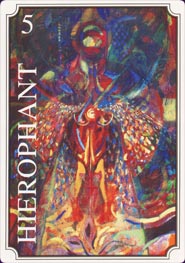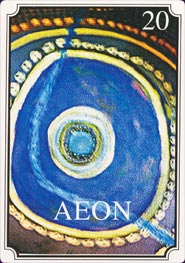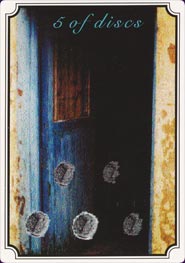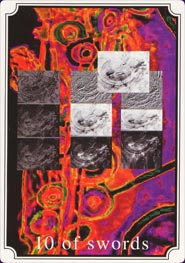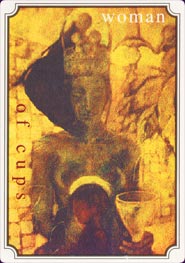Atavist Tarot Deck Review
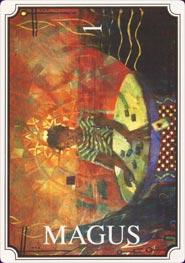
Creators: Sally Annett, Rowena Shepherd
Publisher: Foulsham
The Atavist Tarot is a non-traditional and original deck, with abstract images from various sources on its fully illustrated cards. Recommended for more experienced readers.
Retailers
See Price at Amazon.com (Set)See Price at Amazon.co.uk
See Price at Amazon.com (Cards)
Atavist Tarot Review by Michelle Grooms
This is a 78-card deck with artwork by Sally Annett and a 256-page companion book available in both hardcover and paperback written by Rowena Shepherd. It can be purchased separate from the book or as part of the set from many different vendors for £24.99. Both authors can be linked at http://www.atavists.com. The deck leans on Thoth imagery and meanings, but with a bit of a twist designed to go with this deck only.
Unfortunately, most of the praise for this deck has come directly from the authors themselves, with little to no positive reviews from other sources. The companion book describes the deck as “A magical combination of knowledge and inspiration from two extraordinarily psychic people, Sally Annett and Rowena Shepherd,” while the TABI store describes it as “Penetrating to the heart of Tarot Tradition. This deck contains vibrant and expressive imagery, painted in delightful soft but stimulating colours. Designed to provide a source for spiritual inspiration. It is a spiritual tour de force. The accompanying book is certainly modern in its thought and one of the most beautifully written Tarot expositions you can own.”
While the artwork is attractive and original in many places, the deliberate use of an out-of-focus camera for many of the landscape photographs makes the images fuzzy and distracting. Many of the images are digitally manipulated, sometimes shifting the focus to the number and suit of the card but more often than not distracting the reader so much that they can barely read the cards to begin with. Many of the Major Arcana cards are so abstract that the reader really has no idea which card they are looking at. A good example of this is Death. The book describes the card as having a hidden skeletal figure within the picture, but it is so obscure that very few people have ever been able to find it. The artwork is original and very vibrant in its intent, however dark and murky the images appear. But that seems to be the only thing the deck actually has going for it.
The deck itself is in the standard format that most readers are familiar with: Cups, Swords, Wands, and Disks rather than Pentacles or Coins. The Strength card is 11 in this deck, with the Justice Card as number 8. The court cards are Man, Woman, Girl, and Boy, rather than the usual King, Queen, Knight, and Page. There is a repeated use of images between the court cards, using the same face for both the Woman and Girl and the same for Man and Boy with a little digital fuzzing of the pictures to make them appear older. Unless the reader pays attention and focuses on that detail of the picture, it is hard to tell which card you have drawn at times without looking for the written information on the cards. This makes it very hard to read the cards intuitively at all, so this is definitely not a great deck for those of like to read this way. The cards themselves are not very well-made, most of them having very rough edges from the pull-apart cardboard of the cards’ printing process and some still having very wide pieces of excess cardboard on the outside edges of the cards. They are printed on very thin card-stock and are not very sturdy at all. The packaging also leaves a bit to be desired. The storage box that the deck comes in is made of cardboard flaps that the cards fall right through, so the reader would have to invest in a sturdy Tarot box to keep the cards from being damaged. Even a Tarot bag wouldn’t be enough to protect these thin-grade cards.
The companion book is well written and informative, which is a good thing because you definitely need it to be able to read the cards. The usual meanings are distorted and re-arranged to fit the artwork and style of this particular deck. The book is broken up into sections as though you are being taken on a tour of a house, with such titles as “The Front Door” for meeting the deck and “The Hallway” for instructions on reading the cards and using spreads. Shepherd gives a lyrical poem introduction for each card, key meanings, detailed explanations, advice, and history of the symbolism behind the card. She offers a fairly thorough introduction to Qabala with sample readings as well as an extensive chapter on Tarot history. However, some of her essays included in the book seem to have more to do with getting some of her own pet theories in print than actually having anything to do with the deck the book discusses. A major complaint among the readers who have commented on the book is the self-congratulatory prose that both authors have contributed to the book in lieu of actual reviews on their work. Since publication in 2003 there is still only a line or two that actually praises the deck in any way, so the self-praise of the authors is pretty much the only praise to read. The book is an encyclopedia of Tarot knowledge and history, well made and designed to last. If only the publisher had taken such pains with the cards, then the cards may last as long as the book.
This deck may appeal to some who want to add it to their collections for the sake of the artwork, but for reading purposes it just isn’t very practical at all. Intuitive readers will find the deck to clumsy to make much use of at all unless they have some background in art studies. I wouldn’t recommend this deck for beginners, as the twisted explanations will ruin your Tarot studies from the outset. Learn the basics from another deck before turning your attention to this one.
Atavist Tarot Review by Gail Harry
Atavist: [reverting to] something ancient or ancestral.
I admit right now, as a fan of obscure things of all kinds, I enjoy decoding imagery. Here, we'll focus on the cards without reference to the book because I don't have it. In a sense I've come here to support the deck, not to bury it, believing that a few insights will reward you with better understanding, and maybe expand its audience.
When I first bought this deck a few years ago, I was desperate because I had turned up to read without my deck and grabbed it, the only one to be had, at the clearance shop. Back at the table I gasped, and then decided to just do it, flying through the deck on a white-knuckle ride. Why the tension? Because it was so strange and far from a Rider-Waite template. Instead there was a mesh of images and varied symbols, apparently slapped together with a photo software program, collaged beyond recognition and with cards that read both sideways and upright – then there were the reversals! But they worked.
That day, the clients were happy and I was happy because they were generally unrecognisable, so no-one jumped in ahead of me to say things like, "Oooh that looks bad!" (The Devil card) or "Oh no!" (Swords), or even "Does that mean I'm going to die!?" (Death).
After a while I fell back on my usual working deck. I've since gone back to them because intrigue brought familiarity and respect and I am fascinated.
It's 20 years since the artist Sally Annett started painting her series of the Fool's journey of archetypes in 1994, finishing her "Atavist [Interloper]" paintings in 1998. These large canvases (153x92 cms or, 5x3 feet) went on to exhibition and publication and the rest is history.
What kind of sense then, do these images make 20 years later? I recognise the motifs of post modernism: pastiche, a level field of images, borrowing and combining traditional with pop images and colours, and colour theory. This deck has all of that, being a deck of its time, since post-modern thought went mainstream in the 80s and 90s. Is context important to "reading" the cards? It helps, but being open-minded is the way.
Then there's the slippage of meanings between cards themselves and within the frame. This might be daunting for folks who like their images to be fixed like the Marseilles deck, or foundational like the Rider-Waite Coleman-Smith deck, with its thematic clones. But it's worth "unpacking" a few of the Atavist cards as an exercise.
A key is that the majors in name and sequence are the same in Crowley's Thoth deck. If you can handle that deck with all its occult and esoteric signifiers, I feel you can handle this one. The symbolism after all, goes back a long way.
Of the aces, Ace of discs is a sunburnt kaleidoscopic shield or buckler, the others are a simple graphic. The court cards are as has been said, man, woman, girl and boy. Swords are various weapons, Cups are companionable tea cups to chalices; Wands feature an ancient tree trunk, stripes and sticks. Discs are whorls, coins, landmarks.
The aesthetic is eclectic, showing the artist's multimedia background, where design ranges from the variable fonts to the now-primitive digital effects from when Photoshop was young. There are torn edges, layering, and the "noise" speckles that render rare meaning about absence and presence. It was fun to work out how these might function – a kind of pictorial "noise" like the nostalgic pre-flatscreen tv "on the blink", or another kind of "veil."
It helps to have a wide image and symbol vocabulary to penetrate this deck, and since ours is a visual culture, a world of ads, selfies and multiple images, with the internet for sources, our image bank builds like a second language. It's one more step to analyse them, which we will do here, pictorially though, leaving interpretation out, for another time.
Among Annett's nod to history, we can find Crowley's Thoth tarot (Lust #10), Gustav Klimt's symbolist "Danae I" (girl of discs) and Matisse's spooky "Blue Door" (5 of discs). She allocates female and male differently. Classic royalty is in there along with African and dream figures. As for individual cards, among my favourites are the Fool, the woman of cups and the Magus. Now join the tour group, and follow me!
The Fool is a blue queen – a spectre from Tudor times, the 1500s. She flings back the lid, rising like Lazarus, with a joker's ruff. (Did she lose her head?) An arcing jester's hat crowns her like doom, her sleeves non-conformist, she's Artemis in a mirrored coat of many breasts. A down-turned and empty book balances on a vast chest, topping a hexagram. Her portal is a pandora's box draped with erased tapestry bearing faint traces of sacred geometry.
The "woman of cups" is almost monochrome. Brown as old Javanese carvings, impassive as wood, she is an avatar, crowned with globes, adorned with feminine symbols of the horned moon, a chalice and an eerie void to her right. There's nothing the colour of water here, but a cast of illusory gold, or waning light.
In the Magus, a haloed young diviner spreads tarot cards. One dives to the floor, others rise through a round space, balanced like a crystal ball on a chequerboard stand, backed by an ancient sea. With its runes, wands, elements, ellipses, vevés, zodiac signs, it has everything to do with magic and the occult.
Whether they are complex or spare, there's lots for consultation here, whether majors or minors. It's worth taking your time over them. They would appeal to the visualiser in us, the historian, the intuitive or occultist.
Physically, yes, the card stock is thin, but mine are still in very good condition and shuffle easily thanks to a nice slip. The colour printing well captures effects, depth and detail. The backing, thumbnails of 25 card fronts in a grid, shows their range from information density to zen space. There were no instructions. The box is just a packet, but you can tape the bottom opening to contain them, or do what many of us do with the cards, wrap them in silk and store them safely. The deck is still available, not yet rocketing up the collector's price index.
Complete Details of Atavist Tarot
Creators: Sally Annett, Rowena ShepherdPublisher: Foulsham
Deck Type: Tarot Deck
Cards: 78
Rating: 12/20 or
Similar Decks to Atavist Tarot
Theme: Abstract< Previous Deck · Back to Top · Next Deck >
Home > Tarot Reviews > Atavist Tarot Review

